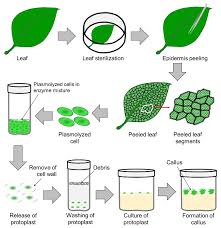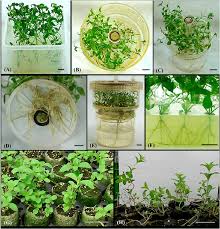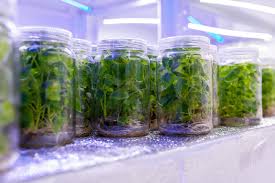Micropropagation is the practice of rapidly multiplying stock plant material to produce a large number of progeny plants, using modern plant tissue culture methods.
Micropropagation is used to multiply novel plants, such as those that have been genetically modified or bred through conventional plant breeding methods.
It is also used to provide a sufficient number of plantlets for planting from a stock plant which does not produce seeds, or does not respond well to vegetative reproduction.
Micropropagation is the aseptic culture of cells, pieces of tissue, or organs. It is possible to regenerate new plants from small pieces of plant tissue because each cell of a given plant has the same genetic makeup and is totipotent, that is, capable of developing along a “programmed” pathway leading to the formation of an entire plant that is identical to the plant from which it was derived.
In addition to its biotechnological applications, micropropagation is used commercially to asexually propagate plants. Using micropropagation, millions of new plants can be derived from a single plant.
This rapid multiplication allows breeders and growers to introduce new cultivars much earlier than they could by using conventional propagation techniques, such as cuttings. Micropropagation also can be used to establish and maintain virus-free plant stock.
This is done by culturing the plant’s apical meristem, which typically is not virus-infected, even though the remainder of the plant may be. Once new plants are developed from the apical meristem, they can be maintained and sold as virus-free plants.
Micropropagation differs from all other conventional propagation methods in that aseptic conditions are essential to achieve success. The process of micropropagation can be divided into four stages:
Stage 1: Initiation Stage in Micropropagation
A piece of plant tissue (called an explant) is (a) cut from the plant, (b) disinfested (removal of surface contaminants), and (c) placed on a medium.
A medium typically contains mineral salts, sucrose, and a solidifying agent such as agar. The objective of this stage is to achieve an aseptic culture. An aseptic culture is one without contaminating bacteria or fungi.
Stage 2: Multiplication Stage of Plant Tissue Culture
A growing explant can be induced to produce vegetative shoots by including a cytokinin in the medium. A cytokinin is a plant growth regulator that promotes shoot formation from growing plant cells.
Stage 3: Rooting or Preplant Stage of Micropropagation
Growing shoots can be induced to produce adventitious roots by including an auxin in the medium. Auxins are plant growth regulators that promote root formation. For easily rooted plants, an auxin is usually not necessary and many commercial labs will skip this step.
Stage 4: Acclimatization of Tissue-Cultured Plants
A growing, rooted shoot can be removed from tissue culture and placed in soil. When this is done, the humidity must be gradually reduced over time because tissue-cultured plants are extremely susceptible to wilting.
Read Also: Different Systems of Rearing Rabbits
Establishment of Plant Tissue Culture

Micropropagation begins with the selection of plant material to be propagated. Clean stock materials that are free of viruses and fungi are important in the production of the healthiest plants.
Once the plant material is chosen for culture, the collection of explant(s) begins and is dependent on the type of tissue to be used; including stem tips, anthers, petals, pollen, and other plant tissues.
The explant material is then surface sterilized, usually in multiple courses of bleach and alcohol washes and finally rinsed in sterilized water. This small portion of plant tissue, sometimes only a single cell, is placed on a growth medium, typically containing sucrose as an energy source and one or more plant growth regulators (plant hormones).
Usually, the medium is thickened with agar to create a gel which supports the explant during growth. Some plants are easily grown on simple media but others require more complicated media for successful growth; the plant tissue grows and differentiates into new tissues depending on the medium.
For example, media containing cytokinins are used to create branched shoots from plant buds, and it happens in a vegetative form.
Multiplication in Tissue Culture Propagation
Multiplication is the taking of tissue samples produced during the first stage and increasing their number. Following the successful introduction and growth of plant tissue, the establishment stage is followed by multiplication.
Through repeated cycles of this process, a single explant sample may be increased from one to hundreds or thousands of plants. Depending on the type of tissue grown, multiplication can involve different methods and media.
If the plant material grown is callus tissue, it can be placed in a blender and cut into smaller pieces and re-cultured on the same type of culture medium to grow more callus tissue.
If the tissue is grown as small plants called plantlets, hormones are often added that cause the plantlets to produce many small offshoots that can be removed and re-cultured; these are all five types.
Read Also: Reasons to use Rabbit Poo (Manure) for our Soil and Crops
Pre-Transplant Stage of Micropropagation

This stage involves treating the plantlets/shoots produced to encourage root growth and “hardening.” It is performed in vitro, or in a sterile “test tube” environment. “Hardening” refers to the preparation of the plants for a natural growth environment.
Until this stage, the plantlets have been grown in “ideal” conditions, designed to encourage rapid growth. Due to lack of necessity, the plants are likely to be highly susceptible to disease and often do not have fully functional dermal coverings and will be inefficient in their use of water and energy.
In vitro conditions are high in humidity and plants grown under these conditions do not form a working cuticle and stomata that keep the plant from drying out.
When taken out of culture, the plantlets need time to adjust to more natural environmental conditions. Hardening typically involves slowly weaning the plantlets from a high-humidity, low-light, warm environment to what would be considered a normal growth environment for the species in question. This is done by moving the plants to a location high in humidity.
Transfer from Culture to Soil Environment
In the final stage of plant micropropagation, the plantlets are removed from the plant media and transferred to soil or (more commonly) potting compost for continued growth by conventional methods. This stage is often combined with the “pre-transplant” stage.
Advantages of Micropropagation in Plant Propagation
Micropropagation has a number of advantages over traditional plant propagation techniques:
1. The main advantage of micropropagation is the production of many plants that are clones of each other.
2. Micropropagation can be used to produce disease-free plants.
3. Micropropagation produces rooted plantlets ready for growth, saving time for the grower when seeds or cuttings are slow to establish or grow.
4. It can have an extraordinarily high fecundity rate, producing thousands of propagules while conventional techniques might only produce a fraction of this number.
5. It is the only viable method of regenerating genetically modified cells or cells after protoplast fusion.
6. It is useful in multiplying plants which produce seeds in uneconomical amounts, or when plants are sterile and do not produce viable seeds, or when seed can’t be stored (e.g., recalcitrant seeds).
7. Micropropagation often produces more robust plants, leading to accelerated growth compared to similar plants produced by conventional methods like seeds or cuttings.
8. Some plants with very small seeds, including most orchids, are most reliably grown from seed in sterile culture.
9. A greater number of plants can be produced per square meter and the propagules can be stored longer and in a smaller area.
Disadvantages of Micropropagation in Agriculture
Micropropagation is not always the perfect means of multiplying plants. Conditions that limit its use include:
1. It is very expensive and can have a labour cost of more than 70%.
2. A monoculture is produced after micropropagation, leading to a lack of overall disease resilience, as all progeny plants may be vulnerable to the same infections.
3. An infected plant sample can produce infected progeny. This is uncommon if the stock plants are carefully screened and vetted to prevent culturing plants infected with virus or fungus.
4. Not all plants can be successfully tissue cultured, often because the proper medium for growth is not known or the plants produce secondary metabolic chemicals that stunt or kill the explant.
5. Sometimes plants or cultivars do not come true to type after being tissue cultured. This is often dependent on the type of explant material utilized during the initiation phase or the result of the age of the cell or propagule line.
6. Some plants are very difficult to disinfest of fungal organisms. The major limitation in the use of micropropagation for many plants is the cost of production; for many plants, the use of seeds, which are normally disease-free and produced in good numbers, readily produce plants (see orthodox seed) at a lower cost.
For this reason, many plant breeders do not utilize micropropagation because the cost is prohibitive. Other breeders use it to produce stock plants that are then used for seed multiplication.
7. Mechanisation of the process could reduce labour costs, but has proven difficult to achieve, despite active attempts to develop technological solutions.
Do you have any questions, suggestions, or contributions? If so, please feel free to use the comment box below to share your thoughts. We also encourage you to kindly share this information with others who might benefit from it. Since we can’t reach everyone at once, we truly appreciate your help in spreading the word. Thank you so much for your support and for sharing!

